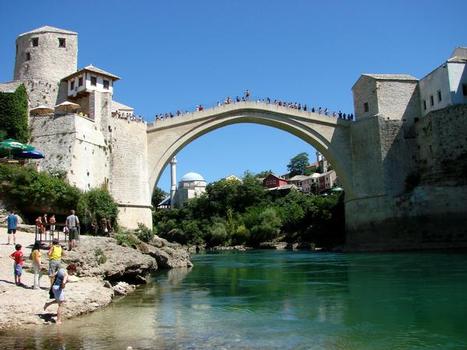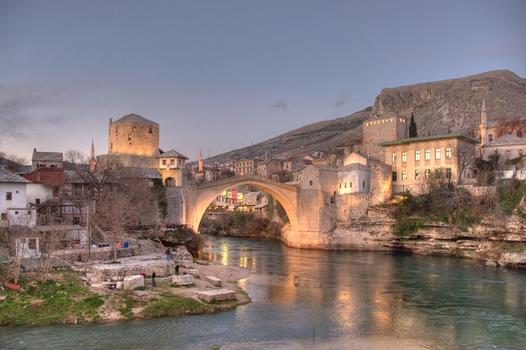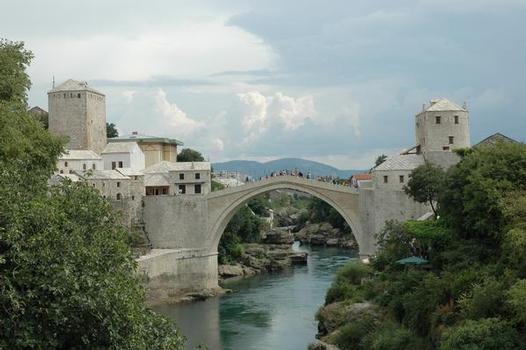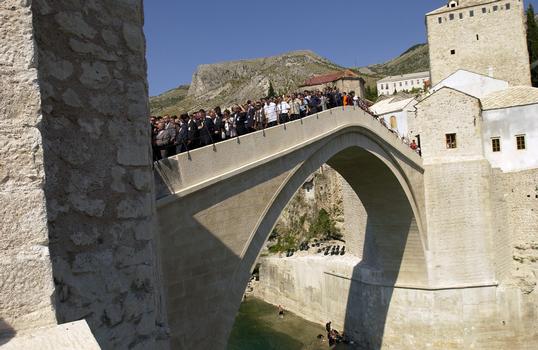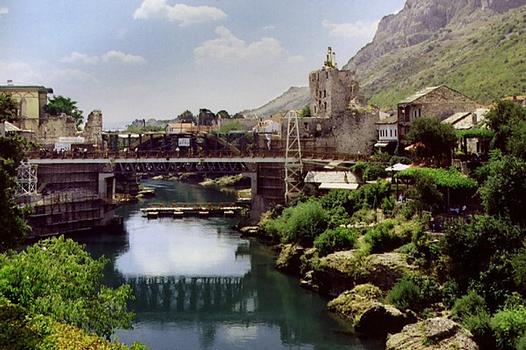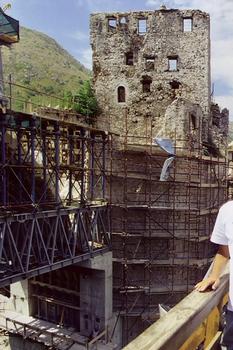General Information
Project Type
| Structure: |
Semi-circular arch bridge |
|---|---|
| Function / usage: |
Road bridge |
| Material: |
Masonry bridge |
| Support conditions: |
for registered users |
| Deck levels: |
Structurae Plus/Pro - Subscribe Now! |
Awards and Distinctions
| 2005 |
part of an ensemble
for registered users |
|---|
Location
| Location: |
Mostar, Federation of Bosnia and Herzegovina, Bosnia and Herzegovina |
|---|---|
| Crosses: |
|
| Coordinates: | 43° 20' 13" N 17° 48' 54" E |
Technical Information
Dimensions
| height | 19 m | |
| span | 27.30 m |
Materials
| arch |
stone
|
|---|
Chronology
| 9 November 1993 | Croats shell the bridge to destruction. |
|---|---|
| 2001 | Reconstruction begins after two years of archeological research. |
| 23 July 2004 | Re-opened after careful reconstruction. |
Notes
Listed as a UNESCO world heritage site.
The reconstruction cost 15 million Euros.
Excerpt from Wikipedia
Stari Most (literally 'Old Bridge'), also known as Mostar Bridge, is a rebuilt 16th-century Ottoman bridge in the city of Mostar in Bosnia and Herzegovina that crosses the river Neretva and connects the two parts of the city. The Old Bridge stood for 427 years, until it was destroyed on 9 November 1993 by Croat paramilitary forces during the Croat–Bosniak War. Subsequently, a project was set in motion to reconstruct it; the rebuilt bridge opened on 23 July 2004.
The bridge is considered an exemplary piece of Balkan Islamic architecture. It was designed by Mimar Hayruddin, a student and apprentice of architect Mimar Sinan who built many of the key Sultan's buildings in Istanbul and around the empire.
Characteristics
The bridge spans the Neretva river in the old town of Mostar, the city to which it gave the name. The city is the fifth-largest in the country; it is the center of the Herzegovina-Neretva Canton of the Federation of Bosnia and Herzegovina, and the unofficial capital of Herzegovina. The Stari Most is hump-backed, 4 metres (13 ft 1 in) wide and 30 metres (98 ft 5 in) long, and dominates the river from a height of 24 m (78 ft 9 in). Two fortified towers protect it: the Halebija tower on the northeast and the Tara tower on the southwest, called "the bridge keepers" (natively mostari).
Instead of foundations, the bridge has abutments of limestone linked to wing walls along the waterside cliffs. Measuring from the summer water level of 40.05 m (131 ft 5 in), abutments are erected to a height of 6.53 metres (21 ft 5 in), from which the arch springs to its high point. The start of the arch is emphasized by a molding 0.32 metres (1 ft 1 in) in height. The rise of the arch is 12.02 metres (39 ft 5 in).
History
The original bridge was commissioned by Suleiman the Magnificent in 1557 to replace an older wooden suspension bridge of dubious stability. Construction began in 1557 and took nine years: according to the inscription the bridge was completed in 974 AH, corresponding to the period between 19 July 1566 and 7 July 1567. Tour directors used to state that the bridge was held together with metal pins and mortar made from the protein of egg whites. Little is known of the building of the bridge, and all that has been preserved in writing are memories and legends and the name of the builder, Mimar Hayruddin, a student of Ottoman architect Mimar Sinan. Charged under pain of death to construct a bridge of such unprecedented dimensions, Hayruddin reportedly prepared for his own funeral on the day the scaffolding was finally removed from the completed structure. Upon its completion it was the widest man-made arch in the world.
According to the 17th century Turkish traveler Evliya Çelebi, the name Mostar itself means "bridge-keeper." As Mostar's economic and administrative importance grew with the growing presence of Ottoman rule, the precarious wooden suspension bridge over the Neretva gorge required replacement. The old bridge on the river "...was made of wood and hung on chains," wrote the Ottoman geographer Katip Çelebi, and it "...swayed so much that people crossing it did so in mortal fear". In 1566, Mimar Hayruddin designed the bridge, which was said to have cost 300,000 Drams (silver coins) to build. The two-year construction project was supervised by Karagoz Mehmet Bey, Sultan Suleiman's son-in-law and the patron of Mostar's most important mosque complex, the Hadzi Mehmed Karadzozbeg Mosque.
The bridge, 28 meters long and 20 meters high (90' by 64'), quickly became a wonder in its own time. The traveler Evliya Çelebi wrote in the 17th century that: the bridge is like a rainbow arch soaring up to the skies, extending from one cliff to the other. ...I, a poor and miserable slave of Allah, have passed through 16 countries, but I have never seen such a high bridge. It is thrown from rock to rock as high as the sky.
Destruction
The Old Bridge was destroyed on 9 November 1993 during the War in Bosnia and Herzegovina. After its destruction a temporary cable bridge was erected by Spanish military engineers in its place.
Newspapers based in Sarajevo reported that more than 60 shells hit the bridge before it collapsed. Croatian General Slobodan Praljak argues in his document "How the Old Bridge Was Destroyed" that there was an explosive charge or mine placed at the center of the bridge underneath and detonated remotely in addition to the shelling that caused the collapse. Most historians disagree and believe his research was trying to absolve his men and himself from crimes committed during the war. He has since committed suicide by drinking poison after being convicted of war crimes.
After the destruction of the Stari Most, a spokesman for the Croats admitted that they deliberately destroyed it, claiming that it was of strategic importance. Academics have argued that the bridge held little strategic value and that its shelling was an example of deliberate cultural property destruction. Andras Riedlmayer terms the destruction an act of "killing memory", in which evidence of a shared cultural heritage and peaceful co-existence were deliberately destroyed.
Both sides of the city remained linked until the bridge's reconstruction by the Spanish and Portuguese military engineers assigned to the United Nations Protection Force (UNPROFOR) mission.
Reconstruction
After the end of the war, plans were raised to reconstruct the bridge. The World Bank, the United Nations Educational, Scientific and Cultural Organization (UNESCO), the Aga Khan Trust for Culture and the World Monuments Fund formed a coalition to oversee the reconstruction of the Stari Most and the historic city centre of Mostar. Additional funding was provided by Italy, the Netherlands, Turkey, Croatia and the Council of Europe Development Bank, as well as the Bosnian government. In October 1998, UNESCO established an international committee of experts to oversee the design and reconstruction work. It was decided to build a bridge as similar as possible to the original, using the same technology and materials. The bridge was re-built with local materials and Ottoman construction techniques by the Turkish company Er-Bu. Tenelia stone from local quarries was used and Hungarian army divers recovered stones from the original bridge from the river below. Reconstruction commenced on 7 June 2001. The reconstructed bridge was inaugurated on 23 July 2004, with the cost estimated to be 15.5 million US dollars.
Diving
Stari Most diving is a traditional annual competition in diving organized every year in mid summer (end of July). It has taken place 477 times as of 2013. It is traditional for the young men of the town to leap from the bridge into the Neretva. As the Neretva is very cold, this is a risky feat and requires skill and training, though TripAdvisor has said tourists do dive as well. In 1968 a formal diving competition was inaugurated and held every summer. The first person to jump from the bridge since it was re-opened was Enej Kelecija.
Text imported from Wikipedia article "Stari Most" and modified on July 22, 2019 according to the CC-BY-SA 4.0 International license.
Participants
- Mimar Hajrudin (architect)
Relevant Web Sites
-
archINFORM: Brücke über die Neretva - Stari Most (Alte Brücke), Mostar





-
BBC News: Historic Mostar bridge being rebuilt (7.6.2001)

-
BBC News: Work begins on Mostar bridge (7.6.2001)

-
Efforts to Reconstruct the Mostar Bridge...

-
General Engineering: Stari Most

-
Mostar Hypertext: Stones of Mostar

-
Wikipedia: Stari Most

Relevant Publications
- (2002): Bridge. The Architecture of Connection. Birkhäuser, Basel (Switzerland), pp. 208.
- (2017): Bridges. A History of the World's Most Spectacular Spans. 2nd edition, Black Dog & Leventhal, New York (USA), ISBN 978-0316507943, pp. 22-23.
- (1997): Bridges. A history of the world's most famous and important spans. Black Dog & Leventhal, New York (USA), pp. 24-25.
- (1998): Brücken. Die Geschichte berühmter Brücken. Könemann, Cologne (Germany), pp. 24-25.
- (1986): Brücken. Historische Entwicklung - Faszination Technik. 2nd edition, Verlag Anton Schroll & Co., Vienna (Austria), pp. 146.
- About this
data sheet - Structure-ID
20000259 - Published on:
19/05/1999 - Last updated on:
28/05/2021

